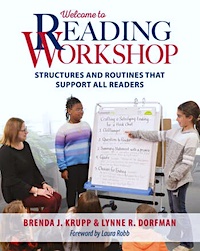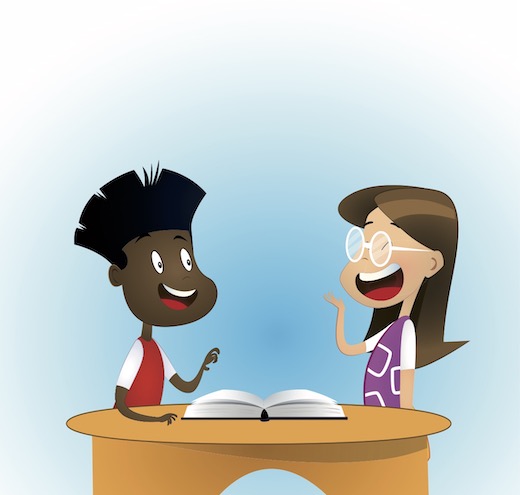Use ‘Say Something’ to Boost Reader Response
Also see the authors’ first article: Why Reader Response Is So Important for Students.
By Lynne R. Dorfman, Brenda Krupp & Aileen Hower

Lynne
People tend to view reading as a solitary behavior, but in many ways, reading is a social act. When we engage in conversations about a text, we extend the experience by sharing our thinking and expecting feedback.
When we share our responses in writing, we can revise our thinking by adding or deleting information. Our viewpoints can change as we work our way through our own understanding, engage in critical thinking, and consider others’ opinions.

Brenda
As students become more adept at thinking and responding to their reading, they move to greater independence. We can help students grow as responsive readers if we give them myriad opportunities for both oral and written response across the day, not just in the ELA classroom.
The power of student collaboration
Collaborative engagement with texts will help our readers hone their ability to think through a text and write a response.

Aileen
Partnerships and small groups that work together toward a common goal help each person be more productive and efficient. A collaborative, creative team can create better content faster. Each person’s thinking helps enrich the thinking of the other members of the partnership or group.
Sometimes, reading a complex text by yourself does not result in deep comprehension. Partner reading can improve confidence, self-esteem, and overall comprehension.
One way to process difficult reading is to read a sentence or several sentences and summarize what you and your partner think the author was trying to say.
If it is a nonfiction piece, clarify the terminology by examining the features of nonfiction such as graphs, diagrams, and photos with captions. Infer, draw from previous experiences, and have conversations about ways to problem solve and seek understanding.
This reading practice is exactly what you would expect from proficient readers when comprehension is essential.
The Say Something protocol
We use Say Something to give students the opportunity to collaboratively interpret text and check for understanding. Say Something was developed by Egawa and Harste (2001) for constructing meaning from text-based information. This protocol was developed by Expeditionary Learning based on Egawa and Harste’s work.
Here’s how Say Something works: Through structured exchanges, partners think out loud, supported by active listening, to deepen individual and shared understandings. The time frame for this strategy is intentionally brief. Rather than reading through a text without focus, this strategy teaches students to attend to their reading by stopping to “say something” at intervals in the text.
Students can use headings to help them divide the text into meaningful chunks or just reach consensus with their partner(s) about where to stop to “say something.” These intervals can be used to respond with comments, questions, or connections. Sentence starters can assist reluctant readers or students who find it difficult to “say something.”
Partners can choose to comment on a specific aspect of the text such as the big idea, the author’s style or purpose, or how the author reveals his characters to his readers. Students’ responses should be text-dependent and rooted in the text to support their developing understanding of the text.
Students take turns, and if the partner cannot “say something,” then the readers reread the chunk silently or in a whisper read together or one reader reads quietly to the other. It is important that each partner take a turn.
Depending on students’ skill levels and the text complexity, Say Something may need to be modeled by the teacher as a think aloud. Even strong readers may think that what they have to say isn’t worth sharing. Students can be set up with sentence starters designed to help them address the text with their comments. The teacher should model how to do each of these responses:
- Make a prediction
- Ask a question
- Clarify something you misunderstood
- Make a comment
- Make a connection (When Kids Can’t Read: What Teachers Can Do by Kylene Beers, NCTE)
Beers suggests helping striving readers by providing sentence starters (Beers, 2002. When Kids Can’t Read: What Teachers Can Do: A Guide for Teachers 6-12, First Edition). For example, for help with making a prediction, here are some useful starters to help students formulate a response:
- I predict that…
- I bet that…
- I think that…
- Since this happened (fill in detail), then I bet the next thing that is going to happen is…
- Reading this part makes me think that this (fill in detail here) is about to happen…
- I wonder if…
- I would imagine that…
Say Something is an important strategy for reader response across the day. This routine relies heavily on speaking and listening skills to improve reading comprehension. Student partners (or a small group) can work together to interpret what is being read.
Meaningful conversations about the text may often include issues of identity, diversity, and action. Active listening and respectful speaking are practiced. Content area and ELA teachers can integrate this practice in ways that meet the goals of both culturally responsive education and improved literacy.
A quick word about making partnerships
Creating partners is a dynamic activity. Sometimes we want to allow students to choose a partner, but at other times we want students to stretch themselves and work with less familiar or comfortable peers.
We don’t want to switch up partnerships too frequently, but if a partnership is really working to help students grow and expand their thinking, we don’t want to dissolve this work too quickly, either.
When reading together, students should not be paired by matching the highest reader with the lowest. Rather, teachers should match the highest readers with middle readers and middle readers with lower readers so that there’s equitable skills. For the middle grades, we recommend that student pairs work with a slightly higher text than the lower reader typically reads.
The neediest students should not be partnered with other students – they should work with the teacher or another adult in a small group. The teacher can model and facilitate how to participate in reader response to help guide their thinking and response.
Some final thoughts
When we give students time to respond to their reading through the act of writing – and thus prepare them for reading discussions with colleagues, or in a whole group or a book club – we are helping to grow readers. What we make time for in our busy day shows our students what we value. We validate their perspectives and elevate them to the level where they consciously understand, “I am a reader who reads because it matters to me.”
Dr. Lynne Dorfman has a reading specialist certificate from LaSalle University and a doctoral degree in educational leadership from Immaculata University. She spent 38 years in Upper Moreland Township (PA) School District as a classroom teacher, a teacher of gifted education (K-5), a writing coach, a literacy coach and reading specialist, and a staff developer.

Brenda Krupp received a Master of Education in Curriculum & Instruction from Penn State University and a Bachelor of Science in Education from Temple University. She taught third grade at Franconia Elementary School for over 25 years and also served as teacher-on-assignment, coaching teachers in reading and writing practices.
Brenda was co-director for the PA Writing & Literature Project for many years and has also facilitated various courses in the teaching of writing, consulted with school districts on teaching writing (K-5), and served as a member of the Writing Project state network. She is co-author, with Lynne Dorfman, of Welcome to Reading Workshop: Structures and Routines That Support All Readers.
Dr. Aileen Hower is an Associate Professor and Graduate Coordinator for the M.Ed. in Language and Literacy Program at Millersville University in Pennsylvania. She also is Coordinator for the Early Childhood Education Online Degree Completion Program. Aileen has presented at PCTELA, KSLA, NCTE, and ILA and facilitates the summer institute on reading and writing at Millersville University each year.
Aileen has been President of the Keystone State Literacy Association and currently serves on the executive board as the KSLA ILA Coordinator and is co-chair of the Keystone to Reading Secondary Book Awards. She is working on a book for ASCD on student reflection across the day with Dr. Persida Himmele, Dr. Lynne Dorfman, and Mrs. Catherine Gehman.



































